Birdfinding.info ⇒ Common across much of eastern and southern Africa, and more locally in far western Africa and as an introduced species in northern Italy, Taiwan, and the eastern U.A.E.
African Sacred Ibis
Threskiornis aethiopicus
Family: Threskiornithidae
Sub-Saharan Africa and the Middle East.

Approximate natural distribution of the African Sacred Ibis. © BirdLife International 2018
Occurs in wetlands, grasslands, and the margins of rivers, lakes, and other waterbodies across most of sub-Saharan Africa, and locally—or sporadically—north along the Nile River to Egypt and Israel, and east to the Persian Gulf and Oman. Generally tolerant of human development, including settlements and agricultural areas.
In western and central Africa, it was formerly present throughout the Sahel region, but has been reduced to three remnant populations in: (1) Senegambia, from southwestern Mauritania to Guinea-Bissau; (2) southwestern Cameroon; and (3) central and southern Chad, southwestern Sudan, and northern Cameroon. Possibly persists elsewhere in West Africa, as it is occasionally detected along the upper Niger River and in coastal Nigeria.
In eastern Africa, it is widespread in appropriate habitat from eastern Sudan and Eritrea south to Cape Town. In the southwest, it occurs north to southern Angola and western Zambia. It is mostly absent from the Congo region, but occurs locally or sporadically along the coast from Gabon to Angola.
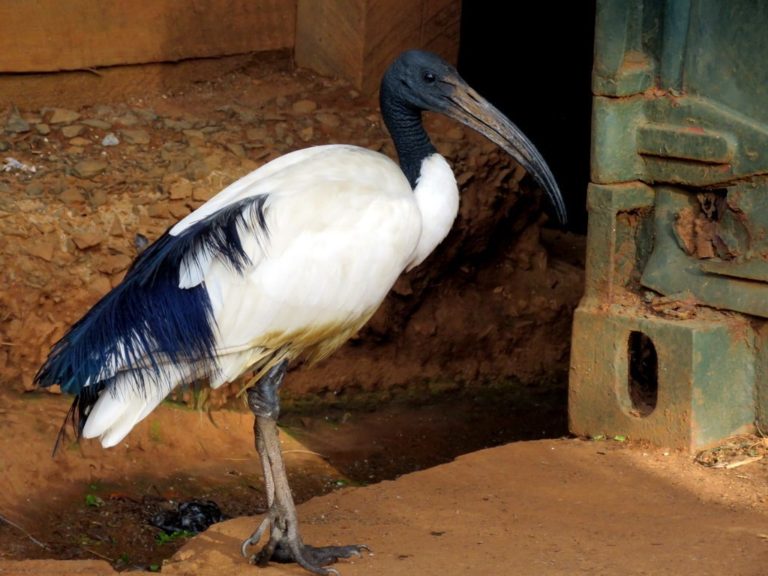
African Sacred Ibis, evidently adapted to an urban lifestyle. (Nairobi, Kenya; May 30, 2017.) © Diego Carús
Mostly extirpated from its former range in Egypt and the Middle East, but a small outpost population apparently persists in the Tigris-Euphrates River Delta area of Iraq and Iran, and small numbers have been found regularly in Yemen and Socotra. Recently introduced populations appear to be established in Bahrain and the eastern United Arab Emirates. A small population in southern Oman may have arrived naturally via Yemen. Also occasional as a vagrant to Israel (possibly including some escaped birds).
In Europe, an introduced population is well-established in the Po River Valley of northern Italy, and evidently expanding south along the Mediterranean coast (at least as far as Naples) and east into Slovenia and Croatia. A smaller population in western France near the mouth of the Loire River has been established since the late 1970s or so.
Small numbers occur regularly in southern France and around the Iberian Peninsula—these presumably originate from either western France or northern Italy, or both, and may be establishing additional breeding areas. Isolated wanderers have been detected sporadically in northwestern Europe north to England, the Netherlands, Germany, and Poland.
An introduced population on Taiwan is well-established and apparently continues to grow, but is not known to have expanded elsewhere in East Asia. However, small numbers of unknown origin have appeared in central Thailand since 2005.
Small introduced populations in southeastern Florida and on Fuerteventura in the Canary Islands did not become self-sustaining.
Identification
Distinctive within its range: a predominantly white, long-bodied ibis with a long, heavy, decurved, scythe-shaped bill. The bill and legs are black. Best distinguished from similar related species by the extensive black border on its wings, visible mainly in flight.
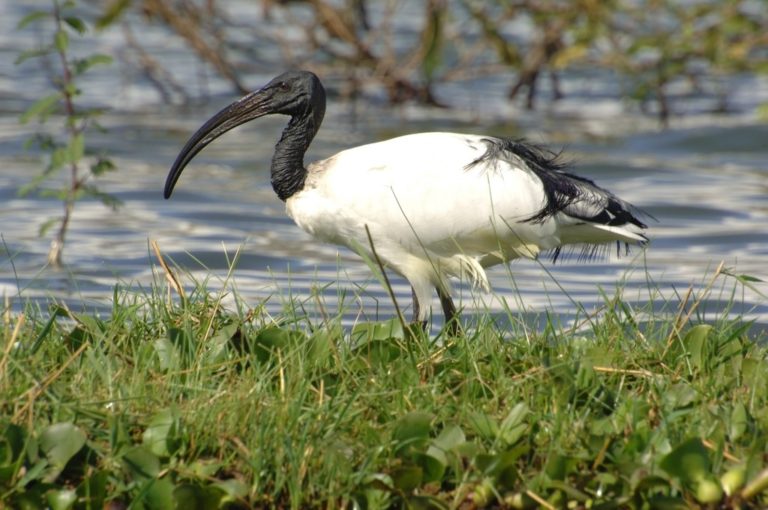
African Sacred Ibis. (Karagita, Kenya; October 8, 2007.) © Mike Loomis
The adult has a naked, black-skinned head and neck, and exuberant black ornamental plumes on its back and rump. The ornamental plumes shine iridescent green or purple in strong lighting.

African Sacred Ibis showing exuberant black plumes on the back. (George, Western Cape Province, South Africa; November 27, 2016.) © Colin Ralston
Immatures are like adults, but with a salt-and-pepper mix of black-and-white feathering on the head and neck, and less-developed plumes on the back and rump.
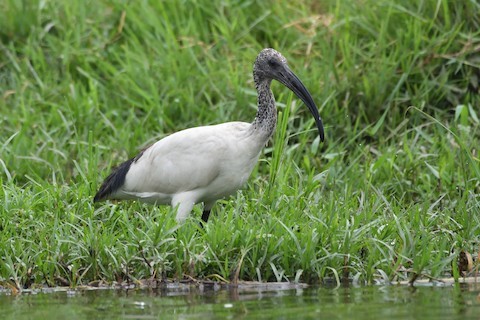
African Sacred Ibis, immature, showing salt-and-pepper feathering on the head and neck. (Queen Elizabeth II National Park, Uganda; January 24, 2019.) © Santiago Caballero Carrera
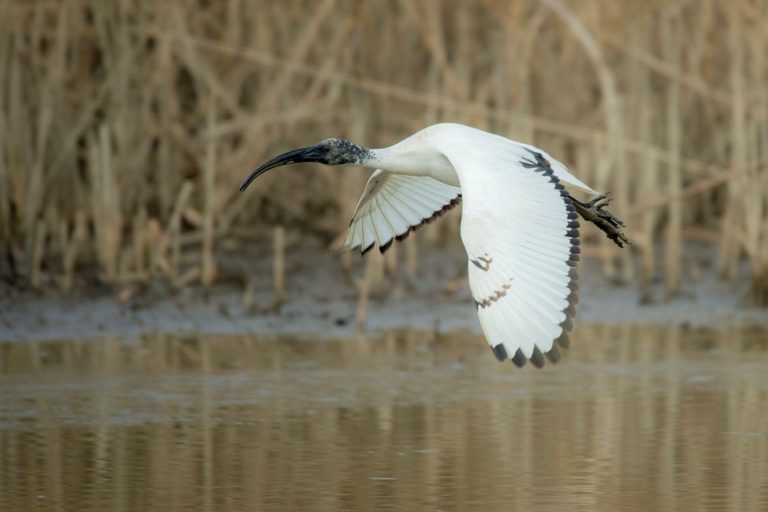
African Sacred Ibis, immature, dorsal view in flight. (Brescia, Lombardia, Italy; January 21, 2019.) © carmonte

African Sacred Ibis, ventral view in flight showing broad black tips on all flight feathers. (Klein Brak River, Western Cape Province, South Africa; October 10, 2021.) © Colin Ralston
In flight, shows wings that are white with a crisp, black border on the trailing edge—broad black tips on all flight feathers.
The underside of each wing has a strip of bare, red skin through the coverts that is often narrow and inconspicuous, but sometimes wide and vivid scarlet.

African Sacred Ibis with wings raised, showing broad, vivid red strip of bare skin on the underwing. (Crescentino, Vercelli, Piemonte, Italy; June 10, 2018.) © Paolo
Notes
Monotypic species. Formerly considered conspecific with the Malagasy Sacred Ibis (bernieri), known collectively as the Sacred Ibis (Threskiornis aethiopicus).
More Images of the African Sacred Ibis

African Sacred Ibis. (Cathkin Park, KwaZulu-Natal, South Africa; April 29, 2021.) © Dave Brown
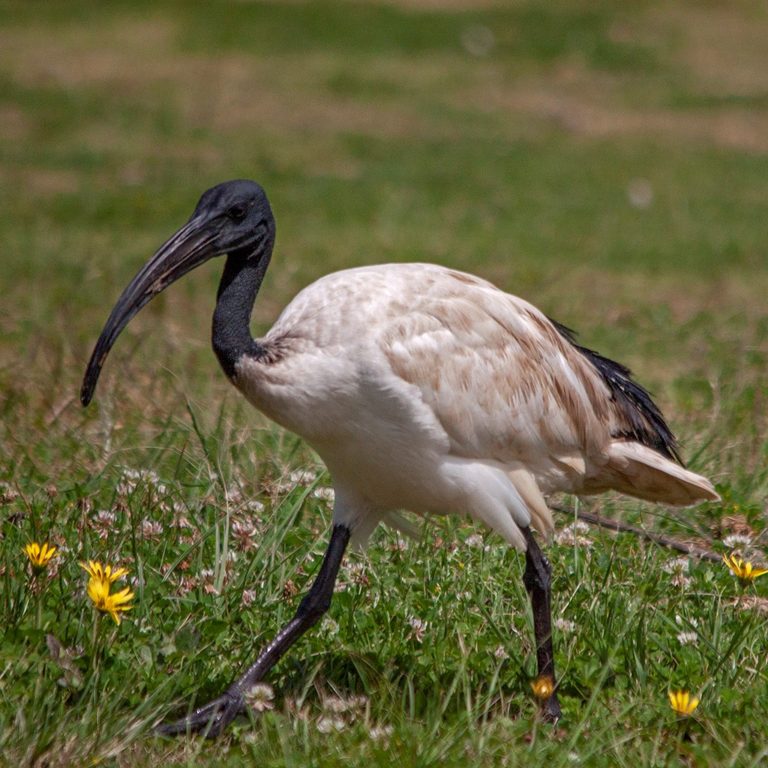
African Sacred Ibis. (Sedgefield, Western Cape Province, South Africa; October 22, 2021.) © Mary Hunter
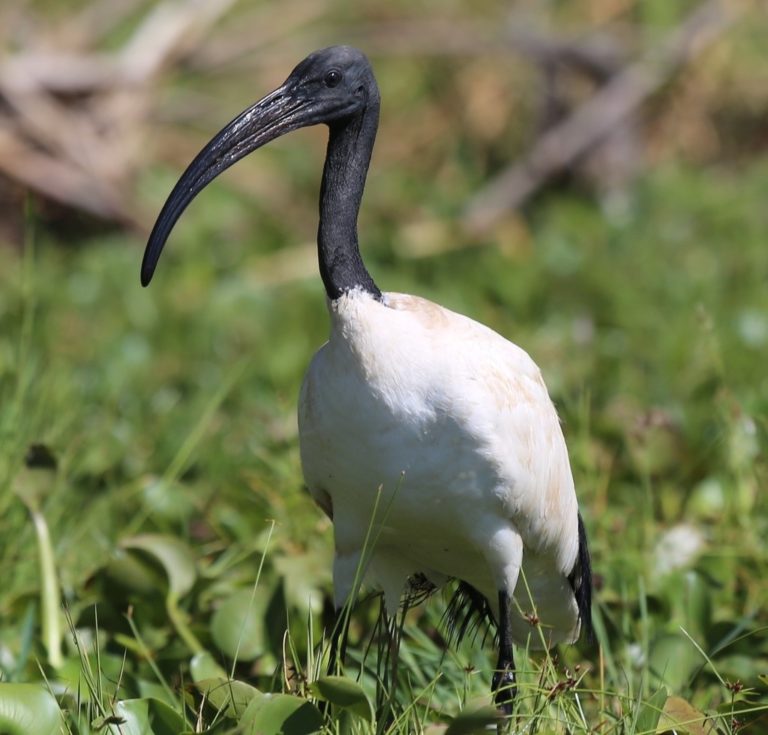
African Sacred Ibis. (Nakuru, Kenya; January 22, 2017.) © nedursley

African Sacred Ibis, immature, showing salt-and-pepper feathering on the head and neck. (Queen Elizabeth II National Park, Uganda; October 2, 2019.) © Theresa Bucher
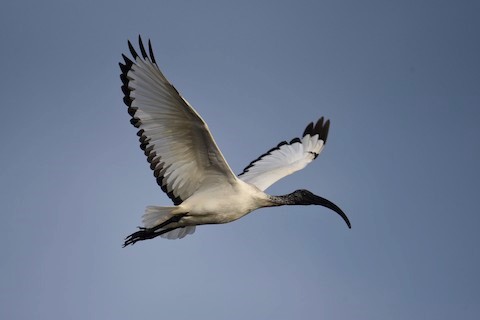
African Sacred Ibis, immature. (Bo-Langvlei, Wilderness, Western Cape Province, South Africa; June 27, 2021.) © Regard Van Dyk

African Sacred Ibis, ventral view in flight, regrowing molted inner primaries. (Venice, Italy; July 11, 2021.) © GF
References
BirdLife International. 2018. Threskiornis aethiopicus. The IUCN Red List of Threatened Species 2018: e.T22697510A132068562. https://dx.doi.org/10.2305/IUCN.UK.2018-2.RLTS.T22697510A132068562.en. (Accessed April 27, 2022.)
Borrow, N., and R. Demey. 2004. Birds of Western Africa. Princeton University Press.
Brazil, M. 2009. Birds of East Asia. Princeton University Press.
eBird. 2022. eBird: An online database of bird distribution and abundance. Cornell Lab of Ornithology, Ithaca, N.Y. http://www.ebird.org. (Accessed April 27, 2022.)
Garcia-del-Rey, E. 2011. Field Guide to the Birds of Macaronesia: Azores, Madeira, Canary Islands, Cape Verde. Lynx Editions, Barcelona.
Garcia-del-Rey, E. 2018. Birds of the Canary Islands. Christopher Helm, London.
Porter, R.F., S. Christensen, and P. Schiermacker-Hansen. 1996. Field Guide to the Birds of the Middle East. T & A D Poyser, London.
Redman, R., T. Stevenson, T., and J. Fanshawe. 2009. Birds of the Horn of Africa: Ethiopia, Eritrea, Djibouti, Somalia, and Socotra. Princeton University Press.
Sinclair, I., and P. Ryan. 2003. Birds of Africa South of the Sahara. Princeton University Press.
Sinclair, I., P. Hockey, W. Tarboton, and P. Ryan. 2011. Birds of Southern Africa (Fourth Edition). Random House Struik (Pty) Ltd. Cape Town, South Africa.
Svensson, L., K. Mullarney, and D. Zetterström. 2009. Birds of Europe (Second Edition). Princeton University Press.
van Perlo, B. 1999. Birds of Southern Africa. Princeton University Press.
van Perlo, B. 2002. Birds of Western and Central Africa. Princeton University Press.
Xeno-Canto. 2022. African Sacred Ibis – Threskiornis aethiopicus. https://xeno-canto.org/species/Threskiornis-aethiopicus. (Accessed April 27, 2022.)
